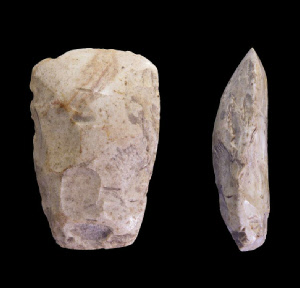Art and Craft

Not an article about kids gluing macaroni and glitter onto card, or beads, crochet and pressed flowers. This is about the link between artistic creativity (Art) and skilled dexterity (Craft).
Ever since the earliest hominids knocked two pieces of flint together and found they could utilise the sharp edges, we have had Craft. Flint-knapping soon became a defining feature of a 2.5 million year long period in our history. Over time, we improved the manufacture of axe heads, knives, chisels and needles, and by the end of the Stone Age (~4,000BC), we had also mastered pottery and bone-crafting, and were starting to understand metalworking. We were also well-acquainted with decorations (Art). Pottery has patterns on it, brooches, beads and necklaces were worn, and we painted hunting scenes on cave walls.
The concepts of Art and Craft seem to be intrinsically linked in our history. If we are able to make something, we will not only make something useful, but also something decorative. These may or may not be the same items.
Through the ages, as manufacturing techniques have improved, we have used more and more decoration. From the Gothic Cathedrals to the Crown Jewels, we work towards more and more intricate designs.
In 1896, architect Louis Sullivan famously stated that “form ever follows function”. Although his original meaning has been twisted, it did lead to a new revolution in design, epitomised by the Bauhaus movement, and the two Modernist tenets “Form Follows Function” and “Ornament is a Crime”. Inspired by the new Machinery that was taking over all methods of production, Modernist architects and Bauhaus designers reduced objects to their essential components, and created an “uncluttered living environment in a technological age”.

The “Form Follows Function” concept held that a design should be towards function, and that, if followed with enough skill, the end result would be artistic in its own way. It needed no decoration, and indeed any decoration would detract from the efficiency and utility of its design and production.
While it could be argued that this was a rejection of Art, it is certainly held nowadays that Bauhaus was an Artistic movement. The very act of rejecting adornment is seen as an Artistic decision.
There is still a following, in all Crafts, of simplistic, minimalist design. A well made item, if following the tenets needed for its utility, and created with its use at the forefront of its design, is often hailed as a pinnacle of Art. This is particularly true for engineering, where simple, elegant solutions are vastly preferred to ungainly, fiddly machines with unnecessary ornamentation. While painted with bright colours and patterns, the engines themselves are built to do their job. No more, no less. Their Art is an emergent property of their design.
This is not to deride the skill of Artists. Often the most respected artists are those who have mastered the tools of their trade, and have learnt techniques that are difficult to emulate. In most genres, it takes more than a creative mind and an eye for interesting concepts to be considered a Master.

In their time, the Impressionists were vilified for producing ‘unfinished’ work, their radical ideas of Art taking time to become accepted. Nowadays, such artists as Degas, Monet and Cezanne are considered pioneers and Masters. While their work (specifically) does not have the detail and realism of a photograph, they still worked hard at ways to present their ideas, to convey the images and emotions to their audience.
On the other end of the scale, there is discussion over whether hyper-detailed drawing or painting is Art (Is photo-realism Art?), or merely reproduction. There is no doubt in the level of talent and ability (Craft) necessary to produce these works, but has any new insight been brought? Is there any creative talent (Art)?
So if Bauhaus is Art and Samuel Silva is Craft, is there really any difference? If I make a tool that you can’t use, does that make it Art? Is a beautifully adorned doorstop Craft? Does it matter?